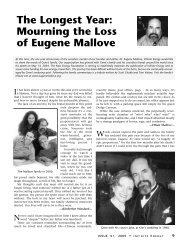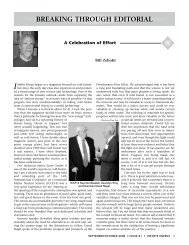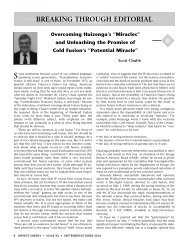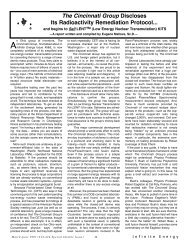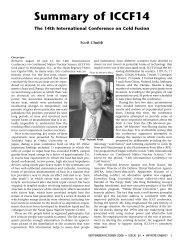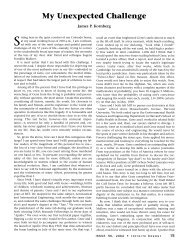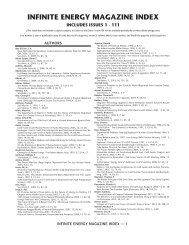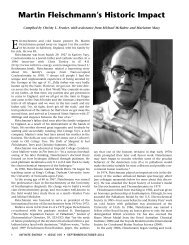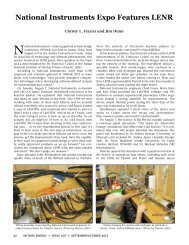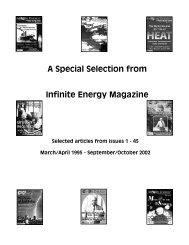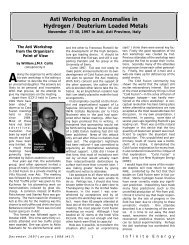MIT and Cold Fusion: A Special Report - Infinite Energy Magazine
MIT and Cold Fusion: A Special Report - Infinite Energy Magazine
MIT and Cold Fusion: A Special Report - Infinite Energy Magazine
You also want an ePaper? Increase the reach of your titles
YUMPU automatically turns print PDFs into web optimized ePapers that Google loves.
teen others) has signed his name. Nothing much has changed for<br />
Dr. Petrasso. In 1997 he was quoted by writer Bennett Daviss: “The<br />
ongoing reports of excess heat <strong>and</strong> nuclear by-products catch people’s<br />
attention about as much as the occasional UFO report. I have<br />
better things to do with my time.” (In TWA Ambassador article, September<br />
1997, see reprint in IE No. 17.) He <strong>and</strong> Professor Parker continue<br />
to spend your money on hot fusion.<br />
There were other negative books, one by DoE’s John Huizenga<br />
(<strong>Cold</strong> <strong>Fusion</strong>: The Scientific Fiasco of the Century, 1992), <strong>and</strong><br />
another by science journalist Gary Taubes (Bad Science: The Short<br />
Life <strong>and</strong> Weird Times of <strong>Cold</strong> <strong>Fusion</strong>, 1993). Taubes became a<br />
Knight Science Journalism Fellow at <strong>MIT</strong> for a year, a nominal<br />
honor for him, if not a disgrace for <strong>MIT</strong>. The <strong>MIT</strong> News Office,<br />
to my knowledge, never published one word about the existence<br />
of Fire from Ice, nor the fact that Fire from Ice was nominated<br />
in 1991 for the Pulitzer Prize by John Wiley & Sons as one of<br />
only two of its books so nominated that year. Professors at <strong>MIT</strong><br />
routinely bombard the News Office with requests that their<br />
every major or minor award be acknowledged in Tech Talk. Virtually<br />
all such requests are granted.<br />
So goes PR at <strong>MIT</strong>—ever protective of the <strong>MIT</strong> Administration<br />
<strong>and</strong> its deficiencies—whether in flaps over an <strong>MIT</strong> student being<br />
killed by an alcohol overdose at an <strong>MIT</strong> fraternity after warnings<br />
were ignored by President Vest (See Boston Globe, October 1, 1997,<br />
p.1 “Students Warned <strong>MIT</strong> on Drinking—Complaints Began in<br />
1992), or the very serious matter of data fudging <strong>and</strong> misrepresentation<br />
by <strong>MIT</strong> hot fusion scientists. The <strong>MIT</strong> Administration<br />
clearly was not happy by the spate of publicity that my resignation<br />
from the News Office generated. It acted accordingly.<br />
The <strong>MIT</strong> PFC continues to receive Federal funding for its lucrative<br />
hot fusion projects—over $250 million since 1989. One of the<br />
ways that <strong>MIT</strong> helps to insure the continued flow of such funding<br />
is by having President Vest sit on the various Federal panels that<br />
make recommendations to the Administration <strong>and</strong> the the Department<br />
of <strong>Energy</strong>. Now that former Physics Dept. Head Professor<br />
Ernest Moniz is a Deputy U.S. Secretary of <strong>Energy</strong>, <strong>MIT</strong>’s ability to<br />
bring influence to bear for hot fusion will be even stronger.<br />
In a 1995 issue of the Journal of <strong>Fusion</strong> <strong>Energy</strong> we find “The<br />
U.S. Program of <strong>Fusion</strong> <strong>Energy</strong> Research <strong>and</strong> Development:<br />
<strong>Report</strong> of the <strong>Fusion</strong> Review Panel of the President’s Council of<br />
Advisor’s on Science <strong>and</strong> Technology (PCAST),” (Vol. 14, No. 2,<br />
1995, pp. 213-250). One of the nine co-authors is none other than<br />
Charles M. Vest. The report’s summary states, in part: “Funding<br />
for fusion energy R&D by the Federal government is an important<br />
investment in the development of an attractive <strong>and</strong> possibly<br />
essential new energy source for this country <strong>and</strong> the world<br />
in the middle of the next century <strong>and</strong> beyond. . .The private sector<br />
can not <strong>and</strong> will not bear much of the funding burden for<br />
fusion at this time because the development costs are too high<br />
<strong>and</strong> the potential economic returns too distant. But funding<br />
fusion is a bargain for society as a whole.” That’s their opinion,<br />
not ours. This is not even the opinion about hot fusion of many<br />
technologists who have nothing to do with cold fusion.<br />
The report states, “. . .we believe there is a strong case for the<br />
funding levels for fusion currently proposed by the U.S. Department<br />
of <strong>Energy</strong> (DoE)—increasing from $366 million in FY1996<br />
to about $860 million in FY2002 <strong>and</strong> averaging $645 million<br />
between FY1995 <strong>and</strong> FY2005.” It goes on to acknowledge that<br />
“Although the program just described is reasonable <strong>and</strong> desirable,<br />
it does not appear to be realistic in the current climate of<br />
budgetary constraints. . .” So the report asks for less, in the tradition<br />
of grabbing for whatever the bureaucracy thinks it can<br />
get: “. . .to preserve what we believe to be the most indispensable<br />
elements of the U.S. fusion effort <strong>and</strong> associated international<br />
collaboration.” The panel recommended about $320 million/year<br />
<strong>and</strong> continues further fantasy thinking about committing<br />
Federal $billions in continued support for ITER (International<br />
Thermonuclear Experimental Reactor). Fortunately, the<br />
U.S. Congress withdrew support from ITER in late 1998.<br />
And, wonder of wonders, the 1995 report speaks directly<br />
about the need to continue to support <strong>MIT</strong>’s Alcator C-Mod tokamak<br />
reactor. I suppose that in the general run of how Federal<br />
funding of science is promoted by numerous interest groups, this<br />
apparent conflict of interest—an <strong>MIT</strong> President recommending<br />
that <strong>MIT</strong> receive further funding for its hot fusion reactor—is not<br />
unusual. However, such advising by <strong>MIT</strong>’s Vest is very unseemly,<br />
when seen in the context of the cut-off of all DoE funding for<br />
cold fusion, resulting from the 1989 negative report <strong>and</strong> from the<br />
<strong>MIT</strong> PFC experiment on which that report was based. Furthermore,<br />
as this history has made clear, President Vest played no<br />
small role in the whitewashing of this 1989 misconduct.<br />
In another report, this one directly to President Clinton on<br />
November 4, 1997, “<strong>Report</strong> to the President on Federal <strong>Energy</strong><br />
Research <strong>and</strong> Development for the Challenges of the Twenty-<br />
First Century,” the <strong>Energy</strong> Research <strong>and</strong> Development Panel of<br />
PCAST, which includes Dr. Vest, we find the general recommendation<br />
spelled out in the cover letter to President Clinton:<br />
“The report recommends an increase, over a five-year period, of<br />
$1 billion in the Department of <strong>Energy</strong>’s annual budget for<br />
applied energy technology R&D. The largest share of such an<br />
increase would go to R&D in energy efficiency <strong>and</strong> renewable<br />
energy technologies, but nuclear fusion <strong>and</strong> fission would also<br />
receive increases. The composition of the R&D supported on<br />
advanced fossil-fuel technologies would change in favor of<br />
long-term opportunities, including fuel cells <strong>and</strong> carbon sequestration<br />
technologies, but the overall spending level for fossil<br />
fuel technologies would stay roughly constant in real terms.” In<br />
table “ES.1” we find the fusion wish list after 1998 in “millions<br />
of as-spent dollars”: 1997—$232 (actual); 1998—$225 (request);<br />
1999—$250; 2000—$270; 2001—$290; 2002—$320; 2003—$328.<br />
The report states that the request for fusion is the “third largest<br />
increase” of the various energy items. It calls the funding “. . .easily<br />
justified as the sort of investment government should be making<br />
in a high-risk but potentially very-high yield energy option<br />
for society, in which the size <strong>and</strong> time horizon of the program<br />
essentially rule out private funding.” Well, virtually all of the scientists<br />
working in cold fusion in 1999 think that cold fusion is,<br />
indeed, “a very-high yield energy option” for society. Private<br />
industry has invested in it in a limited way, <strong>and</strong> more will come.<br />
If it were not for the Federally paid scientists—in hot fusion <strong>and</strong><br />
high energy physics—who assaulted cold fusion with lies <strong>and</strong><br />
deceptions—there would likely be even more private money<br />
now flowing into cold fusion. One thing is certain: no private<br />
company in its right mind will spend any significant money on<br />
tokamak hot fusion, as practiced at <strong>MIT</strong> <strong>and</strong> elsewhere.<br />
What it boils down to is this: By studying the history <strong>MIT</strong> <strong>and</strong> cold<br />
fusion, one learns that paradigm-paralyzed <strong>and</strong> unethical scientists<br />
have the motive <strong>and</strong> means to wreck massive damage against an emerging<br />
science <strong>and</strong> technology, especially when an aging <strong>and</strong> well-financed<br />
program is threatened. An <strong>MIT</strong> President who has access to the highest<br />
power levels of the Federal government should not be contributing to<br />
the distortion of government spending by feathering <strong>MIT</strong>’s nest <strong>and</strong><br />
ignoring facts. <strong>MIT</strong> alumni/ae, students, staff, <strong>and</strong> President Charles<br />
M. Vest need to consider this—E. Mallove<br />
17 <strong>Infinite</strong> <strong>Energy</strong> • ISSUE 24, 1999 • <strong>MIT</strong> <strong>Special</strong> <strong>Report</strong>



